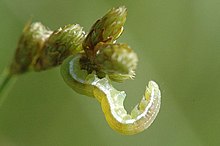Bush grass moth owls
| Bush grass moth owls | ||||||||||||
|---|---|---|---|---|---|---|---|---|---|---|---|---|

Bush grass moth owls ( Deltote deceptoria ) |
||||||||||||
| Systematics | ||||||||||||
|
||||||||||||
| Scientific name | ||||||||||||
| Deltote deceptoria | ||||||||||||
| ( Scopoli , 1763) |

The bush grass moth owl ( Deltote deceptoria ) is a butterfly ( moth ) from the family of the owl butterflies (Noctuidae).
features
The moths reach a wingspan of 23 to 25 millimeters. The head, prothorax and mesothorax as well as the midfield and the fringing of the forewings are dark brown to blackish brown with interspersed black and white scales . The metathorax, the basal area with the exception of the costal margin, the outer transverse line radiating broadly into the edge area and the wavy line as well as the borders of the ring and kidney blemishes and the punctiform cone blemishes are white. The fringes are checked in black and white. The outer and inner transverse lines are mostly black towards the middle field. The hind wings are brownish gray with a dark central spot and a light transverse line, mostly darkened towards the edge. The fringes are white and gray piebald. The abdomen is gray with whitish rings.
The caterpillars are green with a slightly lighter back. The back line is gray, the side back lines whitish, as are the side stripes. The doll is yellow-brown and stocky.
Geographical distribution and habitat
The distribution area extends over central and southern Europe to European Russia. In the north, the species is absent in the British Isles (except for summer immigrants) and apart from the south, in large parts of Scandinavia, and in all of northern Russia.
The species is a typical inhabitant of open, warm grasslands between bushes and forests. It occurs from the lowlands to the hill level of the low mountain ranges and is absent in the higher regions of the low mountain ranges and the Alps.
Way of life
The species forms one or two generations a year, with a second generation only appearing in climatically favorable regions. The moths appear from late April to mid-July and, when a second generation is formed, from July to late August. The moths usually rest during the day, but are easy to scare away. Occasionally they also fly during the day, but mostly at night and sometimes come to light. The rest is noteworthy because it is more reminiscent of certain winder TYPES than cutworm.
The caterpillars can be found from August to October (first generation) and from June to August (second generation). The caterpillars mainly feed on timothy grasses ( phleum ), such as B. timothy grass ( Phleum pratense ) and on other meadow grasses and occasionally on herbaceous plants. Pupation takes place in a web on the ground, the pupa hibernates.
swell
literature
- Arno Bergmann: The large butterflies of Central Germany. Volume 4/2: Owls. Distribution, forms and communities. Urania-Verlag, Jena 1954, DNB 450378381 .
- Günter Ebert (Ed.): The Butterflies of Baden-Württemberg Volume 5, Moths III (Sesiidae, Arctiidae, Noctuidae). Ulmer Verlag Stuttgart 1997. ISBN 3-800-13481-0
- Walter Forster , Theodor A. Wohlfahrt : The butterflies of Central Europe. Volume 4: Owls. (Noctuidae). Franckh'sche Verlagshandlung, Stuttgart 1971, ISBN 3-440-03752-5 .
- Manfred Koch : We determine butterflies. Volume 3: Owls of Germany. Neumann, Radebeul / Berlin 1958, DNB 452481937 .
Web links
- www.lepiforum.de Taxonomy and photos
- Ian Kimber: Guide to the moths of Great Britain and Ireland (English)
- Moths and Butterflies of Europe and North Africa (English)
- Markku Savela's Lepidoptera and some other life forms
- Deltote deceptoria at Fauna Europaea
